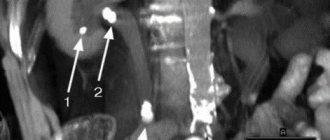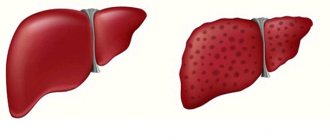Pregnancy is a wonderful time to expect a baby. Enjoyment of this happy period of life is sometimes overshadowed by illness, because a woman’s immunity is weakened while carrying a child.
Thus, difficulty breathing and a runny nose are symptoms that pose a danger not only to the expectant mother, but also to the baby. Less oxygen enters the blood, which can lead to chronic fetal hypoxia.
In this case, it is necessary to start treatment as early as possible. Rinsing the nose with sea water during pregnancy is one of the most effective and safest methods of treating a runny nose and nasal congestion.
General information
Rhinitis (runny nose) is a common phenomenon and often does not entail serious consequences. This is an inflammation of the nasal mucosa with congestion and mucus secretion. Many women in their normal state (outside of pregnancy) do not pay attention to it. But during pregnancy, every expectant mother worries about the health of the child, is afraid of harming him and worries about what medications can be taken. The cause of a runny nose is the entry of viruses, allergens or bacteria into the body, which is accompanied by congestion (nasal obstruction) and mucus discharge from the nose (rhinorrhea). These symptoms are characteristic not only of infectious and allergic rhinitis, but also of vasomotor rhinitis associated with pregnancy and hormonal changes, which is called pregnant rhinitis . We have to find out how these types of rhinitis differ and what drugs can be used during pregnancy to ease nasal breathing.
Nasal rinsing schedule
In what cases and with what frequency should pregnant women wash their nose?
| Disease | Flushing schedule |
| As a preventive measure | 2-3 times a week |
| Inflammatory disease | 4 times a day for one to two weeks |
| For chronic diseases of the upper respiratory tract | Constantly carrying out the procedure 4-5 times a day every day |
A pregnant woman who cares about her well-being and the health of her unborn baby needs to know that rinsing the nasal cavity is an effective measure for the treatment and prevention of many diseases. This procedure does not threaten the health and development of the child, and effectively helps the expectant mother get rid of nasal congestion and runny nose. Sialor® Aqua sea water copes well with these tasks, and the ergonomic packaging in the form of buffets makes its use simple and convenient, wherever you are.
Pathogenesis
The pathogenesis of hormonal rhinitis is not well understood. According to the main hypothesis, the development of rhinitis is associated with increased secretion of estrogen and progesterone during this period of a woman’s life. Estrogens increase the level of acetylcholine (a neurotransmitter of the parasympathetic nervous system) in the blood, the effect of which is manifested by the expansion of the nasal venous network, its overflow with blood, swelling of the nasal turbinates and increased secretion of mucus. Changes in hormonal levels affect the activity of mediators that are involved in allergic and inflammatory reactions. In the first trimester, the placenta produces more histaminase , which destroys histamine in the blood, which is the “culprit” for the development of allergic reactions. Therefore, rhinitis of pregnancy is not typical for the first trimester, and its severe forms develop in the second and third trimesters.
Progesterone , on the one hand, retains fluid in the body, and on the other, reduces the tone of vascular smooth muscles. Both of these factors increase nasal congestion. Progesterone also increases the sensitivity of histamine receptors in the nasal cavity. In this regard, hyperreactivity develops and the symptoms of existing allergic rhinitis intensify. The amount of progesterone increases with the duration of pregnancy.
Treatment
The most effective method of treating acute allergic diseases, manifested by changes in the skin, is to exclude a pregnant woman from contact with allergens. If symptomatic treatment is necessary, H1-histamine receptor blockers are prescribed (20 mg of cetirizine 2 times a day is sufficient). Exacerbations of diseases are usually effectively controlled by oral prednisolone (not recommended in the first trimester). For the treatment of chronic forms with severe symptoms, omalizumab can be used [17].
Classification
A runny nose has a different nature. It could be:
- Allergic rhinitis.
- Infectious runny nose.
- Vasomotor (in this case, associated with hormonal changes - gestational rhinitis ).
Rhinitis in pregnant women (gestational rhinitis) is a common condition observed in every fifth pregnant woman. Nasal symptoms appear at different stages of pregnancy. In some women, vasomotor rhinitis appears in the first weeks of pregnancy. For others, nasal congestion during pregnancy begins in the second and third trimester. There is an explanation for this - from the 16th week, the volume of circulating blood and the level of hormones ( progesterone and estrogen ) increase. These factors cause increased stress on blood vessels, swelling and nasal congestion. In this case, nasal congestion is not accompanied by signs of acute respiratory viral infection or allergies .
This condition does not develop in all pregnant women and not always. Predisposition depends on the level of hormones, characteristics of the nervous system, previous diseases, including the respiratory tract. Blood vessels receive innervation from the parasympathetic and sympathetic nervous systems. If the parasympathetic influence predominates, the vessels are dilated. Added to this is the effect of hormones during pregnancy, so the swelling of the mucous membrane will be more pronounced, and breathing will be significantly more difficult. A pregnant woman experiences wheezing and snoring, which gets worse when lying down. The pregnant women's forum confirms this - women complain that for several months they have a stuffy nose, it is impossible to sleep, and periodically there is mucous discharge from the nose. Women note that washing with a hypertonic solution of sea salt alleviates the condition - this is the only way to save themselves, being careful not to use vasoconstrictor drops.
Allergic rhinitis during pregnancy is a chronic disease, the basis of which is allergic inflammation. Inflammation develops when allergens enter the nasal mucosa. Clinically, allergic rhinitis is manifested by nasal mucus, sneezing, congestion, and loss of smell.
Rhinitis is often combined with bronchial asthma (20-50% of patients have bronchial asthma). The worsening of bronchial asthma also increases the symptoms of rhinitis. About 20-30% of women suffer from allergic rhinitis and 10-20% experience a worsening of symptoms with the onset of pregnancy. Smoking and allergies to house dust are considered provoking factors that increase the symptoms of rhinitis. Mild rhinitis does not interfere with sleep, but severe allergic rhinitis interferes with sleep, daytime activity and performance.
How pregnancy develops in the first trimester
Pregnancy is divided into three periods of three months each, called trimesters. In the first trimester, the basic life systems of the future person are formed, so it is considered very important. – A little more than a day is required from fertilization to the formation of a multicellular embryo. Every day its form becomes more complex. – After two weeks, the embryo already has a neural tube, which gives rise to the brain and spinal cord. Soon a heart will develop and beat in its central part. – On the twenty-first day, the formation of the brain and spinal cord begins. By the end of the first month, the formation of such important organs as the liver, kidneys, digestive and excretory systems begins. – In the fifth week, the respiratory system of the embryo is formed, something like hands appear on the arms, and the gonads begin to form. – In the sixth week, facial features are formed, arms and legs can bend. The retina of the eyes is formed, the intestines grow. – In the seventh week, the placenta appears, which will subsequently produce the hormones necessary for the growth and development of the fetus. The child’s heart becomes four-chambered, large blood vessels are formed, endocrine glands develop, and the brain develops. – From the eighth week, the embryo “acquires” gender, so the Y chromosome begins to direct the process of testicular formation in boys. External genitalia in children of both sexes will be formed by the end of the 9th week. The optic nerve is born. – By the eleventh week, the embryo develops taste buds, and the brain is divided into hemispheres. The development of the cerebellum, responsible for the coordination of movements, begins, and the blood type is determined. What is important for future immunity is that the child’s thymus gland converts stem cells into T-lymphocytes. – By the thirteenth to fourteenth week, teeth are formed. At the same time, the bone marrow produces white blood cells that will fight infections after birth. Outwardly, the embryo already resembles a small person. From weeks 14-17, the bone marrow produces blood cells, the liver secretes bile, and the pancreas produces insulin.
Causes
Based on the forms of the runny nose, we can name the main causes of it in pregnant women:
- Infectious factor. Changes in the immune system during pregnancy cause increased susceptibility to respiratory infections. In this case, rhinitis has a persistent course, is difficult to treat and is complicated by purulent rhinosinusitis .
- Hormonal changes.
- Allergic predisposition of the body.
Provoking factors causing exacerbation of allergic and vasomotor rhinitis are:
- Smoking (active and passive).
- Gastroesophageal reflux (promotes the manifestation of rhinitis and the development of rhinosinusitis).
- Deviation of the nasal septum.
- Nasal polyps.
Symptoms of rhinitis in pregnant women
The main symptoms - congestion and increased secretion appear in connection with pregnancy in the second trimester. Women note that before pregnancy they did not have any problems with nasal breathing. Some pregnant women may experience sneezing. These symptoms are worse when lying down. Long-term course of rhinitis is accompanied by changes in taste and smell. Due to constant nasal congestion, a pregnant woman is forced to breathe through her mouth. When breathing through the nose is impaired, the voice becomes nasal. In addition, it is often complicated by purulent sinusitis , which is persistent and insensitive to antibacterial therapy. It is known that women during pregnancy are 6 times more likely to suffer from sinusitis. Severe rhinitis in pregnant women, if left untreated, can affect the condition of the pregnant woman and the fetus (causes hypoxia ).
How to distinguish it from a regular “cold” runny nose? Rhinitis in pregnant women never occurs with fever, coughing, sneezing and sore throat. Secondly, it lasts a long time - several months and disappears only after childbirth. A runny nose during ARVI occurs with headache , chills , fever, general malaise and other cold symptoms. Characteristic symptoms appear in the first 3 days and decrease by the 6-7th day. Rhinorrhea during ARVI is considered as a protective mechanism - the mucus contains interferon (an antiviral defense factor). In 1-2% of cases, bacterial infection of the mucous membrane occurs. The main signs of a bacterial infection are a temperature of 39 C and purulent discharge. It is also possible for the infection to spread to the paranasal sinuses with the development of sinusitis or sinusitis.
With allergic rhinitis, there is severe swelling of the mucous membrane and congestion, profuse watery discharge from the nose, bouts of sneezing, itching or burning in the nose, redness and itching of the eyes. At the initial treatment, complaints of itching make it possible to suspect the allergic nature of rhinitis.
Differences from colds
There are certain signs that even allow you to independently understand whether a runny nose has a cold or an allergic cause. The main distinguishing feature is that snot in case of an allergic disorder is liquid, transparent, more like water. If the disease is a cold, then the discharge becomes thick, green or yellow-green. They may also have a strong, unpleasant odor. In addition, with a cold, the temperature rises, but with allergies, there is no rise.
Tests and diagnostics
If a pregnant woman consults an ENT doctor, the following examinations will be performed:
- Endoscopy of the nose, which evaluates the condition of the mucous membrane, nasal septum, as well as pathological formations (polyp).
- Rhinoscopy.
- Cytological examination of nasal secretions. Examination of mucus under a microscope is called a rhinocytogram. It is performed for prolonged runny nose. An increased number of eosinophils indicates the allergic nature of the runny nose. An increase in neutrophils indicates a bacterial or viral cause of the runny nose. An increase in lymphocytes is associated with chronic infectious inflammation. With vasomotor and drug-induced rhinitis, there are no eosinophils and neutrophils in the smear.
- Diagnosis of allergic rhinitis involves determining specific IgE.
Prevention
- Maintaining a rest regime, including walks in the fresh air.
- Maintaining air humidity in the room.
- Limiting contact with ARVI patients. During seasonal outbreaks, preventively apply interferon-containing drugs ( Genferon , Reaferon , Grippferon , Viferon , Alfaferon ) locally. Limiting contact with irritants for allergic rhinitis.
- Performing breathing exercises.
- To prevent pharyngolaryngeal reflux , which provokes the development of rhinitis, you should raise the head of the bed, switch to small meals, evening meals 1.5-2 hours before bedtime, limit fats in the diet, stop drinking coffee, strong tea, carbonated drinks, tomato juice and citrus fruits.
What vasoconstrictor do you recommend for a child?
The drug and its concentration depend on age, the list expands as you get older. In the first year of life, oxymetazoline 0.01% and phenylephrine hydrochloride 0.125% are not contraindicated. Unreasonable enthusiasm for decongestants should be avoided in every possible way due to the risk of developing systemic adverse reactions and atrophic rhinitis. These medications should be used as prescribed by your pediatrician.
3 Danilova E. I., Trusova O. Yu., Sumenko V. V., Ignatova T. N. et al. The effectiveness of using inhalations of essential oils in children with acute respiratory diseases // Doctor. RU. — 2021. — No. 4 (133).
Consequences and complications
Why is a runny nose dangerous during pregnancy?
- Nasal obstruction is the most common cause of sleep disturbance and snoring, which leads to high blood pressure in pregnant women and preeclampsia.
- A pregnant woman experiences daytime fatigue, headaches, and difficulty concentrating.
- The risk of developing eustachitis , otitis and sinusitis , which occurs 6 times more often during pregnancy, cannot be excluded.
- With hormonal rhinitis, pustules often form on the inner surface of the nose and the front part of the septum.
Is a runny nose in pregnant women dangerous for the fetus? The consequence of deteriorating nasal breathing is placental dysfunction and fetal hypoxia - the 1st trimester is the most dangerous in this regard, since there is a possibility of the development of abnormalities and even fetal death. In later stages, growth retardation and central nervous system damage may occur.
For a child 0–2 months old, how to reduce the temperature?
The decision is made by the pediatrician, but not every increase in temperature in a child requires correction. Paracetamol and ibuprofen in “children’s” doses are allowed from three months. This threshold can be crossed with the permission of a doctor. Or he will prescribe parenteral administration of drugs (with probable hospitalization). Again, a rise in body temperature during ARVI with normal well-being and behavior of the child does not require any pharmacological therapy. Due to the ongoing “tuning” of thermoregulation systems, low-grade fever in infants may be a normal variant.
Sources
- Yau WP, Mitchell AA, Lin KJ, Werler MM, Hernández-Díaz S. Use of decongestants during pregnancy and the risk of birth defects. Am J Epidemiol. 2013; 178(2):198–208. https://academic.oup.com/aje/article/178/2/198/122453
- Acetaminophen Pregnancy and Breastfeeding Warnings. https://www.drugs.com/pregnancy/acetaminophen.html
- Ibuprofen Pregnancy and Breastfeeding Warnings. https://www.drugs.com/pregnancy/ibuprofen.html
- Bauer AZ, Kriebel D, Herbert MR, Bornehag CG, Swan SH. Prenatal paracetamol exposure and child neurodevelopment: A review. Horm Behav. 2018; 101: 125–147. https://www.sciencedirect.com/science/article/pii/S0018506X17304543?via%3Dihub
- Toda K. Is acetaminophen safe in pregnancy? Scand J Pain. 2017; 17: 445–446. https://www.degruyter.com/view/j/sjpain.2017.17.issue-1/j.sjpain.2017.09.007/j.sjpain.2017.09.007.xm…
- Chirico G, Quartarone G, Mallefet P. Nasal congestion in infants and children: a literature review on the efficacy and safety of non-pharmacological treatments. Minerva Pediatr. 2014; 66(6):549–57. https://www.minervamedica.it/en/journals/minerva-pediatrica/article.php?cod=R15Y2014N06A0549
- …
- King D, Mitchell B, Williams CP, Spurling GK. Saline nasal irrigation for acute upper respiratory tract infections. Cochrane Database Syst Rev. 2015 Apr 20; (4): CD006821. https://www.ncbi.nlm.nih.gov/pubmed/25892369
List of sources
- Review. Prescription of medications for pregnant women / Medical aspects of women's health 2015, No. 1 (87), pp. 48-52.
- Lopatin A. S. Diagnosis and treatment of rhinitis and rhinosinusitis in pregnant women / Russian Allergological Journal No. 1–2006, pp. 12-18
- Kurbacheva O.M., Ilyina N.I. Treatment of allergic rhinitis: when, how and why? // Russian allergological journal. 2006. No. 2. P. 66-75.
- Shuklina Yu.V. Innovative solution to the problem of nasal obstruction in pregnant women / Medical newspaper “Health of Ukraine of the 21st century” 2021. - No. 19 (464).
- Medved V.I. Drug therapy during pregnancy: what should a doctor do? – Women's reproductive health. - 2005. - No. 1. — P. 32-35.
Atopic dermatitis
The course of atopic dermatitis (AD), like other atopic diseases, can worsen, weaken, or remain unchanged during pregnancy [16, 17].
Diagnostics.
AD usually manifests itself in adolescence or early childhood, so patients are well informed about their disease. The most characteristic signs of this disease are [14, 15]:
intense itching;
chronic relapsing course;
skin lesions in the form of a rash that tends to spread;
atopy.
Differential diagnosis.
If AD is suspected, differential diagnosis should include the following diseases [15]:
Idiopathic itching of pregnancy
usually
develops in the first trimester. Its main feature is excoriation. It is assumed that the pathogenesis is based on estrogen-induced changes in liver function, leading to disruption of bilirubin metabolism.
Cholestasis in pregnancy
- characterized mainly by itching of the palms and feet. Of the skin lesions, only moderate excoriations are detected [18]. Itching with cholestasis is explained by an increase in the concentration of bile acids in the blood serum.
Prurigo of pregnancy
-
develops in the second and third trimesters and is characterized by skin lesions in the form of an erythematous-papular rash and excoriations. Skin lesions are localized mainly on the anterior abdominal wall.
Itchy folliculitis in pregnant women
most
often develops in the third trimester. Skin lesions are represented by follicular papules and pustules located on the trunk or limbs.
Treatment of blood pressure
should start before pregnancy. The basis of treatment should be measures to prevent contact of the pregnant woman with allergens and various symptomatic remedies. Methotrexate therapy or photochemotherapy should be discontinued within 3 months. before planned pregnancy [18].
Emollients.
Effective in controlling symptoms of blood pressure. Safe during pregnancy [18].
Antihistamines for oral administration.
Indication for use is severe itching. The drugs of choice are loratadine, cetirizine and chlorpheniramine. Since chlorpheniramine has a pronounced sedative effect, it is recommended to take it in the evening [18].
Topical forms of glucocorticosteroids.
Local use of corticosteroids (weak and moderate strength) has a pronounced therapeutic effect in the treatment of blood pressure and is safe throughout pregnancy [18]. The use of strong and very strong corticosteroids should be limited (especially in the third trimester) due to the proven risk of having a low birth weight baby [19, 20].
The drug of choice is hydrocortisone (0.5–2.5%, 2 times a day, until symptoms are completely relieved). It is recommended to start therapy with this drug due to the fact that, compared to others, it almost does not inhibit the synthesis of endogenous corticosteroids [9]. Medications of medium strength and higher should be applied with caution and only to those areas whose itching is not relieved by weak corticosteroids. If the use of strong or very strong corticosteroids is necessary to relieve symptoms, the lowest effective dose of the drug should be used [18].
Glucocorticosteroids for oral administration.
GCS drugs should be prescribed to patients with hypertension only if therapy with local forms is ineffective. The drug of choice in such cases is prednisolone. The use of GCS should be avoided if possible in the first trimester of pregnancy.
Local forms of tacrolimus and pimecrolimus.
Despite the proven safety of these drugs, their use during pregnancy should be limited due to the insufficient number of clinical studies conducted.
Dupilumab
provides effective relief of AD symptoms by binding the alpha subunit of the receptors for interleukins IL-4 and IL-13. Despite encouraging results from animal testing, due to the lack of clinical studies, this drug is not recommended during pregnancy.
Treatment of bacterial superinfection.
With the development of various bacterial complications of blood pressure (most often due to infection with
Staphylococcus aureus
), it is recommended to prescribe protected penicillins. If you are allergic to penicillin, the drug of choice is erythromycin.








